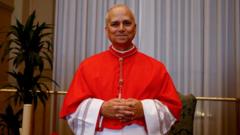Thousands gathered in St. Peter’s Square to witness the election of Pope Leo XIV, marking a significant transition in the leadership of the Catholic Church amidst a pivotal time for its 1.4 billion followers.
Pope Leo XIV Emerges as New Leader of the Catholic Church

Pope Leo XIV Emerges as New Leader of the Catholic Church
Historic Moment as First American Pope Takes Office in Vatican City
In a moment filled with anticipation and joy, Pope Leo XIV made his appearance on the balcony of St. Peter’s Basilica on May 8, 2025, after the cardinals concluded their conclave, which lasted just over 24 hours. The election was signaled by the appearance of white smoke from the Sistine Chapel at approximately 6 p.m. local time, causing celebrations to erupt not only in the square but worldwide as well.
Formerly known as Robert Francis Prevost, the Chicago-born cardinal gains the distinction of being the first American pontiff in history. Dressed in white and red vestments, Leo XIV replaces Pope Francis, who passed away in April. His election follows the largest conclave in recent memory, with over 130 cardinals voting—many appointed by Francis himself—continuing a trend of shorter conclave durations.
As the Catholic Church faces significant challenges regarding its future direction, Leo XIV's supporters have characterized him as a moderate choice, positioned between the progressive reforms of his predecessor and a potential return to more traditional approaches. The scenes of jubilation in St. Peter’s Square, stretching toward the Tiber River, reflected a moment of unity and hope for many believers at this pivotal moment in the Church's history.
Prior to Leo XIV's official introduction, a cardinal proclaimed “Habemus Papa,” meaning “we have a pope,” marking a historic shift for the Catholic Church and its followers as they welcome their new leader into the fold.
Formerly known as Robert Francis Prevost, the Chicago-born cardinal gains the distinction of being the first American pontiff in history. Dressed in white and red vestments, Leo XIV replaces Pope Francis, who passed away in April. His election follows the largest conclave in recent memory, with over 130 cardinals voting—many appointed by Francis himself—continuing a trend of shorter conclave durations.
As the Catholic Church faces significant challenges regarding its future direction, Leo XIV's supporters have characterized him as a moderate choice, positioned between the progressive reforms of his predecessor and a potential return to more traditional approaches. The scenes of jubilation in St. Peter’s Square, stretching toward the Tiber River, reflected a moment of unity and hope for many believers at this pivotal moment in the Church's history.
Prior to Leo XIV's official introduction, a cardinal proclaimed “Habemus Papa,” meaning “we have a pope,” marking a historic shift for the Catholic Church and its followers as they welcome their new leader into the fold.























